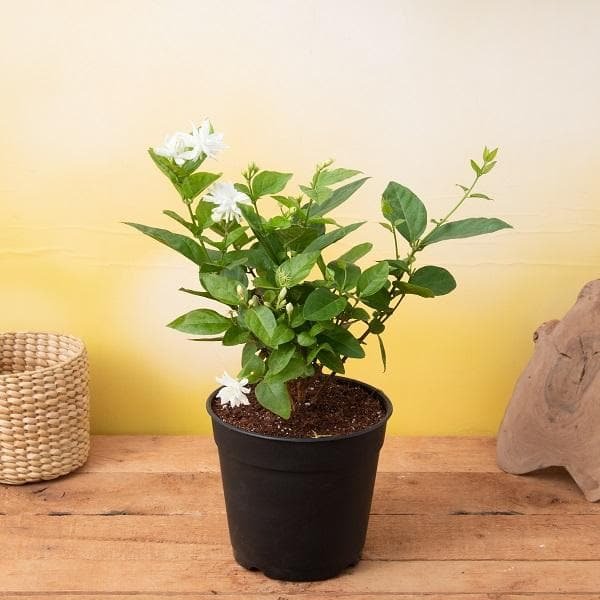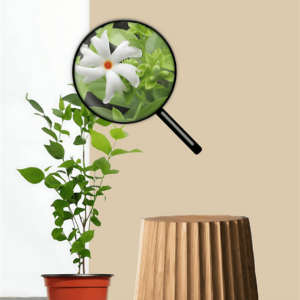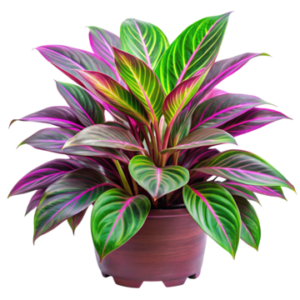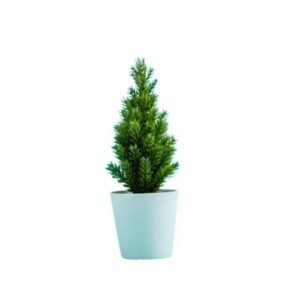Description
Mogra Plant (Jasminum sambac): A Comprehensive Description
The Mogra plant, scientifically known as Jasminum sambac, is a highly revered flowering plant known for its intoxicatingly sweet fragrance and ornamental beauty. Belonging to the family Oleaceae, Mogra is commonly referred to as Arabian Jasmine in English. It holds immense significance across various cultures, particularly in South Asia and Southeast Asia, where it is used in religious ceremonies, traditional medicine, and perfumery.
Botanical Classification
- Kingdom: Plantae
- Clade: Angiosperms
- Clade: Eudicots
- Clade: Asterids
- Order: Lamiales
- Family: Oleaceae
- Genus: Jasminum
- Species: Jasminum sambac
Morphological Features
The Mogra plant is a woody, evergreen shrub or vine that typically grows to a height of 1–3 meters (3–10 feet), depending on the variety and growing conditions.
Leaves
The leaves are opposite, ovate to elliptic, with a smooth, glossy texture. They are typically bright to deep green, measuring about 4–12 cm in length. The foliage is dense and gives the plant a lush, bushy appearance.
Flowers
The most distinctive feature of the Mogra plant is its highly fragrant white flowers. The blooms are generally about 2–3 cm in diameter, composed of several overlapping petals that resemble small roses. The flowers can be single, semi-double, or double in form, depending on the cultivar.
Mogra flowers usually bloom during summer and early monsoon seasons, although in warm climates, flowering may occur year-round. The blooms open in the evening and release their most potent fragrance at night, which is a trait common among night-blooming jasmine species.
Geographical Origin and Distribution
Mogra is believed to have originated in South or Southeast Asia, particularly in regions of India, Myanmar, and the Philippines. Over time, it has been widely cultivated in tropical and subtropical regions around the world, including the Middle East, the Pacific Islands, and parts of Africa.
In the Philippines, the plant is called Sampaguita and is the national flower. In India, it is known by various regional names such as Malli (Tamil), Mallige (Kannada), Mogra (Hindi and Marathi), and Bela (Bengali).
Cultural and Religious Significance
The Mogra flower holds deep spiritual and cultural importance, especially in Hinduism, Buddhism, and traditional Asian customs.
- In Hindu rituals, the flowers are offered to deities, especially to Lord Vishnu and Goddess Lakshmi, symbolizing purity, devotion, and divine blessings.
- Bridal adornment: Women wear Mogra garlands in their hair as a symbol of grace and femininity, especially during weddings and festivals.
- The flowers are used in garland-making (malas) and temple decorations.
- In the Philippines, the Sampaguita is considered a symbol of purity, simplicity, and humility, often associated with national identity and love for the motherland.
Uses and Applications
1. Perfumery and Cosmetics
Mogra’s essential oil, extracted from the flowers, is a valuable ingredient in perfumes, attars, soaps, and lotions. It is particularly used in high-end perfumery due to its heady, rich floral aroma.
2. Traditional Medicine
Mogra has been used in Ayurveda, Unani, and Chinese medicine for centuries. Medicinal uses include:
- Calming agent: The scent has a relaxing effect, used to reduce stress and anxiety.
- Aphrodisiac: Mogra is often included in love potions and massage oils.
- Antiseptic: Leaves and flowers are believed to have antibacterial and anti-inflammatory properties.
- Digestive aid: In some cultures, parts of the plant are used to treat stomach issues and fever.
3. Culinary Use
In some regions, Mogra flowers are used to flavor tea, such as jasmine tea, especially in China. However, Jasminum sambac is used less commonly in culinary applications compared to other jasmine species.
Cultivation and Growing Conditions
Mogra is a relatively easy plant to grow, especially in warm climates. It is popular in home gardens, balconies, and public parks due to its beauty and aroma.
1. Climate
- Thrives in warm, humid tropical and subtropical climates.
- Can tolerate mild frost but not prolonged cold.
2. Sunlight
- Requires full sunlight for at least 5–6 hours daily.
- Can tolerate partial shade but may reduce flowering.
3. Soil
- Prefers well-draining, loamy soil, enriched with organic matter.
- pH should be neutral to slightly acidic.
4. Watering
- Requires moderate but regular watering.
- Avoid overwatering, which can lead to root rot.
5. Propagation
- Commonly propagated through stem cuttings.
- Can also be grown from layering or suckers.
6. Pruning
- Regular pruning encourages bushier growth and more flowers.
- Best done after a major bloom cycle.
Pests and Diseases
While generally hardy, Mogra can be affected by:
- Aphids, spider mites, and whiteflies.
- Fungal infections like root rot and powdery mildew.
Regular monitoring and using organic insecticidal sprays can help maintain plant health.
Varieties and Cultivars
There are several popular varieties of Mogra, including:
- Maid of Orleans – Single-petal variety, blooms profusely.
- Belle of India – Semi-double form, elegant petals.
- Grand Duke of Tuscany – Double-petal variety, resembling miniature roses, highly fragrant.
- Mysore Mallige – A famous variety from South India, known for its intense fragrance and cultural significance.
Symbolism and Spiritual Meaning
Mogra flowers symbolize purity, love, sensuality, and spiritual devotion. In many traditions, they are considered a bridge between the earthly and the divine due to their ethereal fragrance and pristine white color.
In modern aromatherapy and flower therapy, Mogra is believed to help:
- Enhance emotional well-being.
- Promote inner peace and mindfulness.
- Encourage spiritual awakening and clarity.
Environmental Impact
Besides its ornamental and cultural appeal, Mogra plays a role in supporting pollinators like bees and butterflies. It also contributes to air purification, absorbing pollutants and providing oxygen.
Conclusion
The Mogra plant (Jasminum sambac) is a remarkable botanical treasure that blends aesthetic appeal, rich fragrance, cultural depth, and medicinal value. Whether grown in a small pot on a balcony or cultivated in a large garden, this plant continues to inspire poets, gardeners, healers, and spiritual seekers alike. Its resilience and charm make it a beloved presence in both traditional and contemporary landscapes.







Reviews
There are no reviews yet.